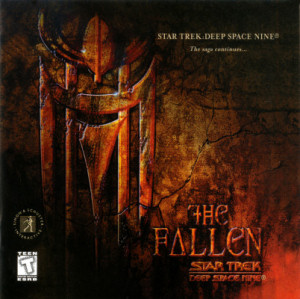

Characters from The Original Series were also re-introduced in DS9, including Kor, Kang, Koloth, and Arne Darvin. Quark (and the station itself) also made a cameo in the pilot of Star Trek: Voyager, " Caretaker".

In addition, Julian Bashir and Quark also had one-time appearances on The Next Generation, in " Birthright, Part I" and " Firstborn" respectively. Several other TNG characters made appearances too, such as Captain Jean-Luc Picard, Thomas Riker, Q, Lwaxana Troi, Kurn, Lursa, B'Etor, Admiral Alynna Nechayev, Vash, Toral and Alexander Rozhenko. Several Next Generation characters also had recurring roles on the show, such as Keiko O'Brien and Gowron. Worf – a major character from TNG – played a large role on DS9. Miles O'Brien, and later Worf, were two characters imported from TNG. Such characters included Nog, Rom, Elim Garak, Dukat, Vedek Bareil Antos, Winn Adami, Weyoun, the Female Changeling, Damar, Martok, Kasidy Yates, Leeta, Brunt, Ishka, and Zek. Unlike other Star Trek series, DS9 also had a large cast of recurring characters. (" Progress", " Shakaar", " The House of Quark", " Heart of Stone", " Prophet Motive", " Little Green Men", " Bar Association", " Body Parts", " Nor the Battle to the Strong", " The Ascent", " The Darkness and the Light", " Business as Usual", " Ties of Blood and Water", " Ferengi Love Songs") Additionally, a number of the episodes and main storylines focused entirely on characters who weren't members of Starfleet: for example, those revolving around Kira, Odo, Jake Sisko, and Quark. The show also broke with tradition – and with the two Star Trek series that followed it – by featuring a commanding officer as the star of the show at the rank of commander, rather than captain, for a significant portion of its run, until Sisko was eventually promoted to captain in " The Adversary". The show broke the "standard format" for Star Trek shows a number of times as well, with a direct, first-person narrative providing the commentary for the episode " In the Pale Moonlight", a retelling of a classic TOS episode from a different angle in " Trials and Tribble-ations", life in the racially segregated 1950s in " Far Beyond the Stars", and a reintroduction of the concept of "black ops" to the Star Trek universe with Section 31: " Inquisition". Unlike its predecessors Star Trek: The Original Series and Star Trek: The Next Generation, Deep Space Nine tended to avoid an episodic format for most of its run and instead featured multiple-episode story arcs. The show is known for its complex characters and storylines, engaging battle scenes and darker (less Utopian) atmosphere. Deep Space Nine goes where no Star Trek series had gone before – DS9 was the first Star Trek production not based on a starship, but instead, a starbase, known as Deep Space 9 (the starship USS Defiant was introduced in season 3, but the station remained the primary setting of the series).


 0 kommentar(er)
0 kommentar(er)
